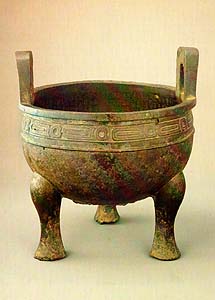Bronze is an alloy of copper, tin, and a small amount of lead. Its appearance signaled the advancement in human culture from the Stone Age to the Bronze Age. For the approximately 2,000 years between the 17th century B.C. up until the Han Dynasty (206 B.C.-200 A.D.), the Chinese people used rare and precious bronze to cast large quantities of ritual vessels, musical instruments, and weapons that were elegant in form, finely decorated, and clearly inscribed with Chinese characters. They affirm the artistic achievement of ancient China, and demonstrate how early Chinese used their ingenuity to create works incorporating both science and art from resources in nature.
In the ritualistic society of ancient China, bronze was employed primarily for the casting of ceremonial temple vessels used in sacrifices to the goods of heaven, earth, the mountains, and rivers. They were also used in vessels for banquets, honor awards, and funerals for the nobility. Because bronze is a durable material resistant to cracking and breakage, it was used by kings to cast inscribed vessels honoring the ancestors of dukes, princes, and ministers who had made a great contribution to their nation or sovereign, to establish a model and reminder for alter generations. The world-famous Mo Kung Ting , for example, a bronze tripod on display at the National Palace Museum in Taipei, was imperially commissioned. On the tripod interior is an inscription 497 characters in length, divided into 32 lines and two halves, extending from the mouth of the vessel to the bottom interior. The inscription is the imperial mandate for the casting of the vessel, written in a stately and powerful tone. The inscription on this particular vessel is the longest among bronzes that have been unearthed so far.

Bronzeware of " Tigher eats man"
Bronzes can be classed into four main types, based on function: food vessels, wine vessels, water vessels, and musical instruments. Within each type, endless variation is to be found in form and design, fully demonstrating the rich imagination and creativity of the Chinese of the time. The kuei, for example, was a container for cooked millet that came in many different styles, equivalent to today's containers for cooked rice. Some had a circular base to stabilize the vessel belly; others had a heavy square base added onto the circular base, in a graceful contrast of geometrical form. The ting was a tripod vessel used for cooking, with a pair of knobs protruding from the mouth to facilitate handling. The three legs held the vessel at just the proper distance from the fire for cooking meat. The ch¹eh was a vessel especially designed for heating and drinking wine; it had a pour spout and side handles. The three legs facilitated warming the wine. The tsun was a major type of wine container that was either round or square in shape, or had a round mouth and square base. Ancient Chinese bronzes stressed balance and symmetry of form, and communicated solemnity and ceremony.
 Mo kung ting
Mo kung ting

Western Zhou Meng kuei bronze from Ch'ang-chia-p'o. Decorative bird theme.